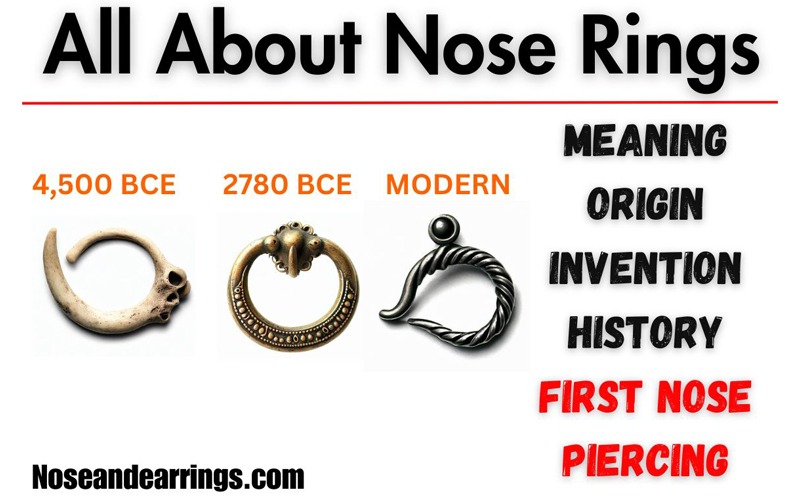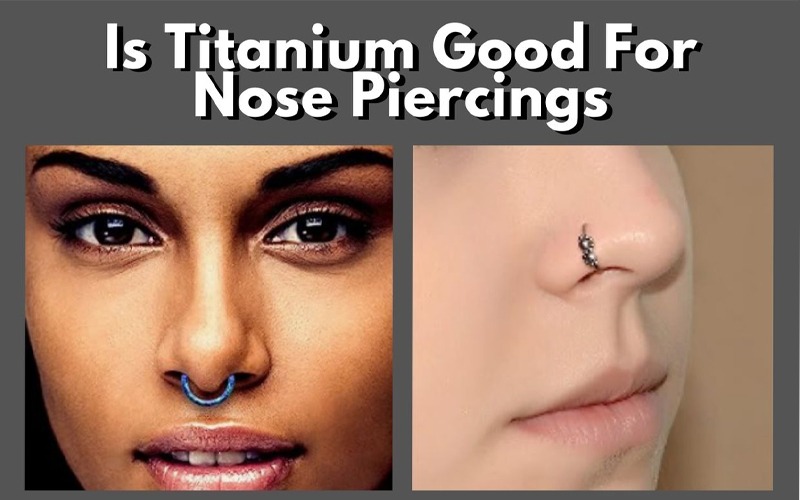The use of surgical steel in the manufacture of nose rings is widespread, attributed to its notable resistance to corrosion and minimal nickel content, which ostensibly reduces the risk of allergic reactions. This material’s prevalence in the body jewelry industry is underpinned by its durability and longstanding record of biocompatibility.
However, the safety of surgical steel nose rings is not a matter that can be universally guaranteed, as individual susceptibilities to even trace amounts of nickel can vary significantly. Moreover, the quality of the surgical steel itself is not homogenous across different manufacturers, which can influence the potential for adverse reactions.
As we scrutinize the various factors that contribute to the safety of these adornments, it is crucial to consider not only the material properties but also the post-piercing care and the wearer’s skin sensitivity. These considerations serve as the basis for a nuanced discussion on whether surgical steel nose rings can be deemed a safe choice for all individuals seeking to express themselves through this form of body modification.
Key Points:
- Surgical steel is a popular choice for nose rings due to its biocompatibility, resistance to corrosion, and minimal nickel content.
- Individuals with severe nickel allergies should consider titanium as a safer alternative to surgical steel.
- It’s important to understand the metal content of body jewelry and opt for implant-grade materials to minimize the risk of skin irritation.
- Proper aftercare, including regular cleaning and avoiding irritants, is crucial for a safe and healthy healing process after getting a nose piercing.
Understanding Surgical Steel
Surgical steel’s biocompatibility makes it a preferred choice for nose rings, especially for individuals with skin sensitivities. This material, known for its robustness and safety in contact with the body, has earned its place as a staple in the world of body piercing. Surgical steel, specifically the 316L variant, is an implant grade stainless steel that adheres to stringent standards, such as those set by ASTM F, ensuring its suitability for long-term wear and its minimal risk of causing allergic reactions or skin irritation.
Unlike other metals that might be used in nose rings, surgical steel contains very little nickel. This trace amount is typically so insubstantial that it does not trigger the same allergic reactions that higher nickel content in lesser quality stainless steels might provoke. For those who celebrate personal expression through body modification but are cautious about the materials they expose their skin to, surgical steel offers a sense of freedom without the worry of adverse reactions.
However, for individuals with a known sensitivity to nickel or who seek absolute assurance against any potential allergic reactions, titanium presents itself as an exemplary alternative. As a completely nickel-free option, titanium is the epitome of hypoallergenic body jewelry. It is essential for consumers to be aware of materials such as brass that can often be found in various styles of nose rings, as these can induce sensitivities in some wearers.
Selecting high-quality, implant-grade materials such as surgical steel or titanium for nose rings is not just a matter of aesthetic preference but one of health and safety, ensuring peace of mind for those who choose to adorn their bodies in this way.
Potential Allergic Reactions
While surgical steel is renowned for its hypoallergenic properties, it is crucial to be aware of the potential for allergic reactions in individuals with severe nickel allergies, for whom titanium may be a safer alternative. Although surgical steel is a popular choice for body jewelry due to its durability and affordability, the presence of nickel, even in trace amounts, might cause an allergic reaction in some people with hypersensitive skin.
To maintain the freedom to express oneself through body art without the constraints of discomfort and allergic responses, consider the following points when choosing piercing jewelry:
- Opt for Implant-Grade Materials: Ensure that the metal used for your nose ring is of implant-grade quality, whether it’s surgical steel or implant-grade titanium, to minimize the risk of skin irritation.
- Understand Metal Content: If you have sensitive skin, it’s important to know that even hypoallergenic metals can contain nickel. Always check the composition of your body jewelry.
- Consult with Professionals: Before getting a piercing, discuss with a professional piercer your history of metal allergies. They can guide you to the most suitable metal options for your unique skin needs.
Allergic reactions can manifest as redness, itching, swelling, or a rash around the piercing site. If you notice any of these symptoms, it may be an indication that the metal used is not compatible with your skin. In such cases, switching to a completely nickel-free option like implant-grade titanium could provide relief and ensure that your self-expression through piercings remains a source of joy rather than discomfort.
Comparing Jewelry Materials
In the realm of body piercings, selecting the appropriate material for nose rings is paramount, as it not only impacts the aesthetic appeal but also ensures skin safety and comfort. Individuals who seek the freedom to express themselves through body art must be informed about the various types of nose rings available and the materials from which they are made.
Surgical steel, known for its durability and luster, is a popular choice. It contains minimal nickel, reducing the risk of cause allergic reactions. However, for those with heightened sensitivities, titanium nose rings offer an even safer alternative. Titanium is completely nickel-free and hypoallergenic, making it ideal for long-term wear.
When considering materials like sterling silver, it’s important to note that while 925 sterling silver is a classic option, it may not match the hypoallergenic properties of surgical steel or titanium. For a luxurious look, gold-plated nose rings are an attractive option, but the quality of the underlying metal is crucial to prevent irritation or allergies.
Implant-grade titanium, often referred to as Grade 23 or Grade 5 titanium, is the pinnacle of quality jewelry for piercings. Its biocompatibility ensures that it does not react with body tissues, thereby providing a safe and comfortable piercing experience. Additionally, for those who prioritize flexibility and comfort, bioflex materials offer a lightweight and hypoallergenic alternative.
Ultimately, choosing high-quality and hypoallergenic materials like implant-grade titanium or high-grade surgical steel is essential to minimize potential allergies, infections, and other complications, allowing for a safer and more expressive piercing experience.
Aftercare and Hygiene
Having considered the importance of selecting the right material for nose rings, it is equally crucial to address the aftercare and hygiene practices that ensure a safe and healthy healing process. After you’ve expressed your individuality through the selection of jewelry, the journey to fully enjoy your new piercing begins with proper aftercare. The healing process following an initial piercing involves a delicate balance that requires not only the highest quality materials but also a commitment to cleanliness and care.
To guide you on the path to optimal healing, here are three essential aftercare steps:
- Daily Cleaning Routine: A cornerstone of aftercare, cleansing the area around your new piercing with antibacterial soap washes away harmful bacteria. This step is vital in preventing infections that could lead your body to reject the nose ring.
- Saline Soaks: Twice daily, use a saline solution or alcohol-free wipes to gently clean your piercing. This practice supports the healing process by keeping the area sterile without introducing harsh chemicals that could cause irritation.
- Avoid Irritants: Makeup, creams, and certain skincare products can cause adverse reactions around a new piercing. To avoid such complications, it’s best to steer clear of these products until your nose ring has completely healed.
The Association of Professional Piercers also emphasizes the importance of not changing your jewelry prematurely. Swapping out your nose ring before the piercing is fully healed, which may take several months, can introduce new bacteria and set back the healing process.
Signs of Piercing Infection
Recognizing the signs of infection after piercing is essential for prompt treatment and to prevent complications. When you choose to adorn your body with a new piercing, such as a steel nose ring hoop, you’re embracing a form of personal freedom and expression. However, it’s vital to keep in mind that any piercing can potentially cause an infection if not properly cared for.
The first sign of piercing infection to be aware of is redness and swelling at the site. A certain amount of this is normal immediately after getting a nose piercing, but if it persists or worsens, it may be cause for concern. Pain and tenderness that escalate rather than improve over time can also signal an infection.
Discharge is another clear indicator. While some clear or white fluid is expected during the healing process, the appearance of pus, especially if it’s yellow or green and accompanied by an unpleasant odor, is a red flag. Additionally, an increase in heat around the piercing compared to the rest of your skin should not be overlooked.
Systemic symptoms such as fever or chills, although less common, are serious signs of piercing infection that require immediate attention. These symptoms suggest that the infection may be spreading beyond the piercing site.
For those considering getting a nose piercing, it’s crucial to choose the right materials, such as high-quality surgical steel, and to follow aftercare instructions meticulously. By being vigilant and responsive to the signs of piercing infection, you can ensure your piercing journey is both safe and satisfying.





